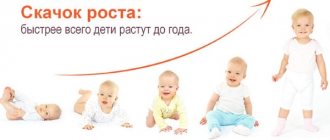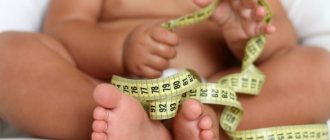The most intensive period of development occurs in the first year of the baby’s life, and if at this time the mother is helped monthly by pediatricians to monitor the development of the baby, then in the second year of life the entire burden of responsibility falls on her herself. To help parents, we provide a table of values that should correspond to the weight and height of a child at 2 years old.
Standards for a two-year-old child
Child development statistics are kept by Russian pediatricians and WHO staff. Moreover, the data of the first and second may differ slightly. This is due to the fact that WHO gives average indicators for children of all participating countries, that is, of different races and nationalities, and pediatricians - at the state level. It's no secret that the average height of Asians is lower than that of Europeans. The situation is similar with other body parameters.
For greater accuracy, we present tables of average values (between the data of WHO and Russian pediatricians) - height, weight, head circumference and chest circumference of a child at 24 months.
Table 1. Parameters of boys at 24 months.
| 24 months, boys | Norm | Permissible deviations from the norm |
| Weight, kg | 12.6 | +/-2.3 |
| Height, cm | 88 | +/-5.4 |
| Head circumference, cm | 48.8 | +/-2.3 |
| Chest circumference, cm | 51.6 | +/-3.2 |
Table 2. Parameters of girls at 24 months.
| 24 months, girls | Norm | Permissible deviations from the norm |
| Weight, kg | 12.2 | +/-2.3 |
| Height, cm | 86.8 | +/-4.2 |
| Head circumference, cm | 47.8 | +/-2.3 |
| Chest circumference, cm | 51.3 | +/-2.8 |
The role of height and weight indicators in assessing development
Everyone knows that for the first time the size of a child is examined in the womb using an ultrasound machine, and then in the delivery room. They are recorded on a tag and on the discharge form. And all this is not without reason, because these are the first indicators that may indicate certain diseases and deviations in the physical development of a small person.
The measurements taken in the maternity hospital are the initial ones: based on them, doctors and parents should assess the baby’s growth rate. And they are important not only in the first month of life.
There are standards for weight gain and height on a monthly and annual basis. The table above shows the average for the average child, but children weigh differently at birth.
Let's take a two-year-old boy who was born with a height of 45 cm. It is quite normal and logical if his height by 24 months is below average - for example, 81 cm. Therefore, parents should not sound the alarm over every missing millimeter and adjust their child to the general framework.
However, if the discrepancy is quite large or you are overly worried about this, it is better to consult a doctor and examine your baby for somatotropic insufficiency (lack of growth hormone). This disease is easily treated if it is detected in time and appropriate hormone therapy is started.
Dwarfism
Now we move to the other extreme - dwarfism. As hard as it may be to guess, this is the opposite of gigantism. It can be identified when a child is much lower than his peers, his development is in one place and is not going to move forward. This disease manifests itself early; the growth of children at 2 years of age can already be an indicator of its development. Therefore, be very attentive to children aged 2-3 years. If a child’s growth has slowed down significantly after 2 years, and instead of the required 10 centimeters, and your baby only gains 2 centimeters, then this is a good reason to consult a doctor. The doctor will order an MRI and hormone tests. Monitor the development of your children, provide proper and healthy nutrition, eat more fruits and vegetables, then you will ensure the active development of your child.
"Normal" deviations
In order not to run to the hospital with each measurement, pay attention to a number of factors that influence the increase in height and weight of boys and girls.
- Gender differences. Nature dictates that in most cases, males are larger than females in all respects. Therefore, parents of girls do not need to worry too much if their daughter turns out to be an inch.
- Heredity. The height of parents plays an important role in this matter. If mom and dad are tall, most likely the child will also be taller than average. Short parents most often have children with low scores, unless, of course, they inherited height from tall grandparents.
- Indicators at birth. As mentioned above, if a child was born short, it is quite normal for him to be shorter than his peers at 2 years old.
- Children's growth spurts. Children's development occurs in leaps and bounds: at 1 month after birth, at 3, 6, 9, 12 months, at 1.5 years, and so on. But this does not mean that at exactly 18 months the child will gain weight from 11 to 12 kg. Some will reach this figure in 1 year and 4 months, and others in 1.5 years and 3 weeks. Therefore, if at 2 years old your baby does not weigh the required 5 kilograms, it is worth carrying out a control weighing in a month or two - it is likely that by then he will exceed this figure.
- Child activity. As you know, some kids prefer quiet games, such as modeling from plasticine or drawing, while others will not sit still for a second, even their mother is changing their clothes, chasing around the entire apartment. Accordingly, the energy expenditure of such children will be different, and a hyperactive child will be slimmer.
- Living conditions of the baby. For normal development, the child must receive sufficient nutrition and walk a lot in the fresh air. Accordingly, children living in areas with unfavorable weather conditions (for example, areas of the Far North) may be stunted due to insufficient sun exposure.
Speech development of a 2.5 year old child
The child knows how to label himself: “I”, “I myself”. Can use sentences of several words (three or more) and ask questions “Where?”, “Where?” and others.
What else can a child say at 2 years 6 months?
- Answers an adult’s questions based on the picture, if the plot and characters are familiar: “Who (what) is this?”, “What is he doing?” Shows with movements what the character does.
- Easily imitates unfamiliar words.
- Repeats words from familiar fairy tales after adults.
- Knows the names of some animals, household items, clothing, and dishes.
- Can tell from a picture (in two or three sentences).
- Answers the question: “What is your name?” (in full or simplified). Knows (and names) the names of close adults and familiar children.
- Talks with peers during games (verbal dialogues). Imitates other children.
- Understands an adult's story.
What contributes to normal development?
In addition to genetic predisposition, weight gain and height are directly influenced by external causes and circumstances.
- The baby's nutrition plays an important role. It must be correct, complete and balanced. If for children of organized leisure (who go to kindergartens) a nutrition program is developed by specialists at the state level, then for a child under two years old sitting at home, the menu is prepared by the mother. Parents need to pay enough attention to studying the daily diet tables for children so that their child is provided with a set of necessary nutrients, vitamins and microelements every day.
- It is imperative to follow a daily routine. Firstly, adherence to the regime - preparing the child for further “adult” life, when he will need to get up in the morning for kindergarten and school. Secondly, for normal growth, the baby needs enough rest and walks outside (especially in the sun).
According to research, the maximum production of growth hormone occurs from 10 pm to 12 midnight, during the deep sleep phase. Therefore, you need to put your baby to bed no later than 21:00, so that by 22:00 he is in deep sleep.
- Sufficient physical activity. Exercise and active games should be an integral part of your daily routine. Even better, parents can sign up their child for swimming or attend group family fitness classes.
How does a 2 year old child develop socially and emotionally?
Emotional, active, active state. Usually the child is in a good mood when performing independent, skillful actions, with a positive assessment from an adult. Sometimes he is stubborn, demanding what is prohibited, insisting on his own. Sometimes he is dissatisfied and refuses to act if an attempt fails.
Screaming, gesticulating, capricious:
- if you are unwilling to comply with an adult’s request,
- imitating a loved one, another child,
- to attract attention.
- Disobedient, gets angry when movements are restricted, in response to the rude tone of an adult.
- Refuses to communicate (hides) with an unfamiliar adult.
- She cries for a long time when her mother leaves, when she is scared, when she is offended.
- Smiles, gestures, looks into the eyes to keep the attention of an adult or another child, and expects praise.
- Shows vivid emotions when communicating with loved ones (facial expressions, exclamations, movements).
- Smiles and uses emotionally charged speech when playing with children.
- Gets pleasure from independently pronounced syllables and words.
- Emotionally interested in music, singing, small folklore forms, outdoor games, the attitude towards them is differentiated (active movements, looseness, enchantment, inhibition).
- Enthusiastic about entertainment, including games.
- Shows emotional memory in familiar situations. He watches cartoons and children's television programs with interest.
Emotionally anticipates results:
- own action,
- actions of an adult.
Empathizes, sympathizes with a crying child, an elderly person, treats animals and plants with care:
- following the example of an adult,
- on one's own initiative (rarely).
Emotionally restrained, able to wait a little (after an adult’s explanation). He is calm about the instructions: “Get the toys”, “this is possible”, “this is not possible”. Understands the words: “good”, “bad”.
How a baby gains weight and height during the second year of life
In the second year of life, the baby's growth rate is slightly lower than in the first year. If by the year a child gains about 30 cm in height, then from the first to the second birthday - 10-12 cm, that is, on average 1 cm per month. But the terms from the 12th to the 24th month become conditional. The baby may not grow for 3-4 months, and then in a month it will stretch before our eyes, and the metric will show a mark of +5 cm.
With weight gain during this period, things are as follows: every month the child should gain within 200 grams. It is considered normal if children gain about 2.5 kg in the second year.
When measuring the anthropometric indicators of their child, parents should build on the average data given in the tables and perceive them as approximate, and not the only normal ones. In any case, if you are concerned about the results of measuring the height and weight of your two-year-old baby, it is better to seek a professional assessment from a pediatrician in order to save your nerves and not miss anything important in the development of your baby.
Boys at 2 years old, features of physical development
Two year olds are very active. The lives of children are filled with new knowledge, movements and emotions. During this period, psychological character is formed. The child already runs, jumps, plays outdoor games and speaks. Having mastered the skills, the kids skillfully use them. A lot of calories are consumed during this period, which affects physical development.
The height and weight of a two-year-old boy are becoming more stable. At this age, children are still unfamiliar with the full range of gastronomic tastes, but they already have an appetite and their own preferences. Many parents mistakenly believe that their children have matured and they can forget about conventions. The eating schedule is disrupted, foods that are undesirable for this age appear in the daily diet and those that are necessary disappear. Unbalanced nutrition is one of the main causes of abnormal physical development.
Much depends on genetic characteristics. If parents are tall and tend to be overweight, children acquire these predispositions by inheritance, but not always. There are other, more serious factors for the appearance of deviations:
- Gastrointestinal tract disorders.
- Diseases of the genitourinary system and kidneys.
- Rickets.
- Disturbances of the endocrine system.
- Anemia.
Average height and weight indicators must be determined and constantly monitored. Parents should monitor monthly increases even after two years. It is very important to know the parameters and their compliance with age-related development standards.











